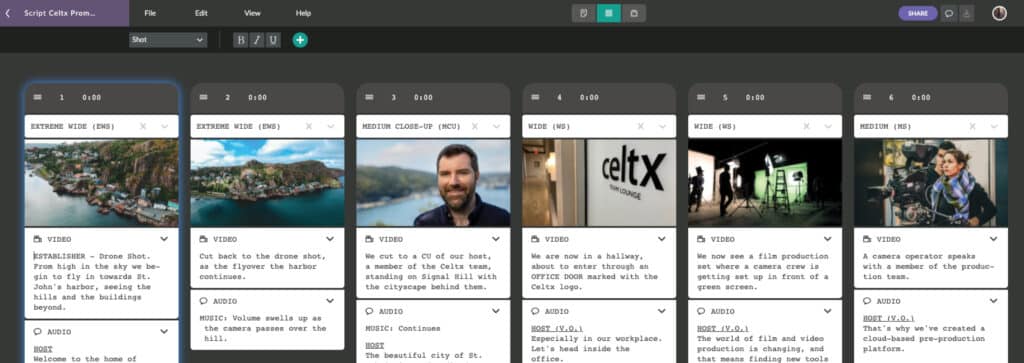

7.4K
Butch Cassidy and the Sundance Kid; Han Solo and Chewbacca; and Casablanca’s Rick Blaine and Louis Renault are among the many memorable duos to hit the big screen. Despite their differences, these unlikely pairs joined forces to overcome all odds. These characters often face impossible situations on-screen but manage to work together to persevere while reminding us of the value of teamwork and cooperation towards a goal larger than the sum of its parts.
Offscreen there’s another iconic duo worth mentioning – the scriptwriter and director. Behind the scenes, these two creative forces work together to make scripts into great video content.
But throughout the process, it’s not unheard of to see creative minds clash. This is where an AV script template comes into the picture.
An AV script is a document that separates a script into audio and visual components. It details each scene’s visual actions and corresponding audio. To create an AV script, form two columns in a document and record the audio and visual elements for every scene, providing a comprehensive breakdown.
Similar to something like a call sheet template, AV script templates can be great starting points if you want to help foster greater collaboration between your creative team, an . To quote Humphrey Bogart, it may just lead to “…the beginning of a beautiful friendship.”
You don’t have to be working on the next Hollywood blockbuster to know the importance of creative collaboration within your pre-production team. Whether your next media project is a TV commercial for a client or a documentary series, it’s important that scriptwriters and directors put their heads together early in the editing process to prevent the need for rewrites that can lead to later production bottlenecks.
While the traditional single-column script format is typically used for feature film production, when it comes to television and corporate video content, an AV script template like the two-column AV format is pretty standard. The two-column AV script template differs from the single-column format in that it splits script content into two distinct columns: One for video and visual descriptions, and another for audio, dialogue, and narration.
By dividing the script into two streams, you can blueprint a shooting script where visual and audio cues are paired together. A two-column AV script template allows the director and assistant directors to co-create and visualize how to best bring the scriptwriters’ written words to life alongside the scriptwriter.
While two-column AV script templates are available for many word processing, or task management applications, they do not possess the integration that most modern studios employ to prevent siloed workflows. For this reason, Celtx recommends an AV script template that is part and parcel of an integrated scriptwriting and pre-production solution such as the Celtx Multi-Column AV Script editor.
If your creative team creates scripts for television commercials, product demos, and documentaries it’s possible you’re already familiar with formatting and using two-column script templates, and if so you might be wondering what’s next. Enter Celtx Multi-Column AV editor.
Whereas the two-column AV allows you to format and organize script and visuals in separate columns, the newer Multi-Column AV script editor addresses the needs of modern creatives and their workflows with greater command over production assets.
Celtx’s Multi-Column AV script editor organizes your shots, each made up of three columns: video, audio, and image. Shots also contain a detail section, which includes fields to specify production specs, such as equipment, angles, and lenses: everything you need to plan out your production and communicate that plan with your team for two-way communication.

The Celtx Multi-Column AV editor is designed to complement your workflow by blending scriptwriting, storyboarding, and shot planning together in an adaptable format. Fully collaborative and highly presentable, the Multi-Column AV editor also includes a suite of production planning and management tools – ready to help you take your scriptwriter’s ideas through to completion.
Here’s a few good reasons to consider using the Celtx Multi-Column AV editor rather than a typical two-column AV template:
The Multi-Column AV editor combines a traditional two-column script with an integrated storyboarding module. With a new shot-based formatting structure, your writing and your imagery work together to tell your story.
You can expand your scriptwriter’s script with a comprehensive shot list system that allows your director to easily create highly detailed technical descriptions that complement your storyboard images.
Multi-Column AV scripts are sharp, eye-catching, and ready to be shown off. With one click you can turn your scripts into digital presentation boards that are ideal for communicating your concepts to both the client and your production team.
Great video content for film and TV starts with a great script, but that’s just the beginning. The Multi-Column AV editor includes all of Celtx’s industry-leading tools, including script breakdowns, production cataloging, budgeting, scheduling, and auto-generated call sheets for a more comprehensive solution to video production.
While creative tension can often help improve creative output, it can also lead to disagreement and conflict that can derail a video production. By providing your scriptwriters and directors with an AV script template like the Celtx Multi-Column AV editor, you foster greater creative collaboration across two streams: the written and the visual. By fostering collaboration at the earliest stage, you can ensure the editing process is a shared one between your scriptwriter and director and ultimately create a better final product.